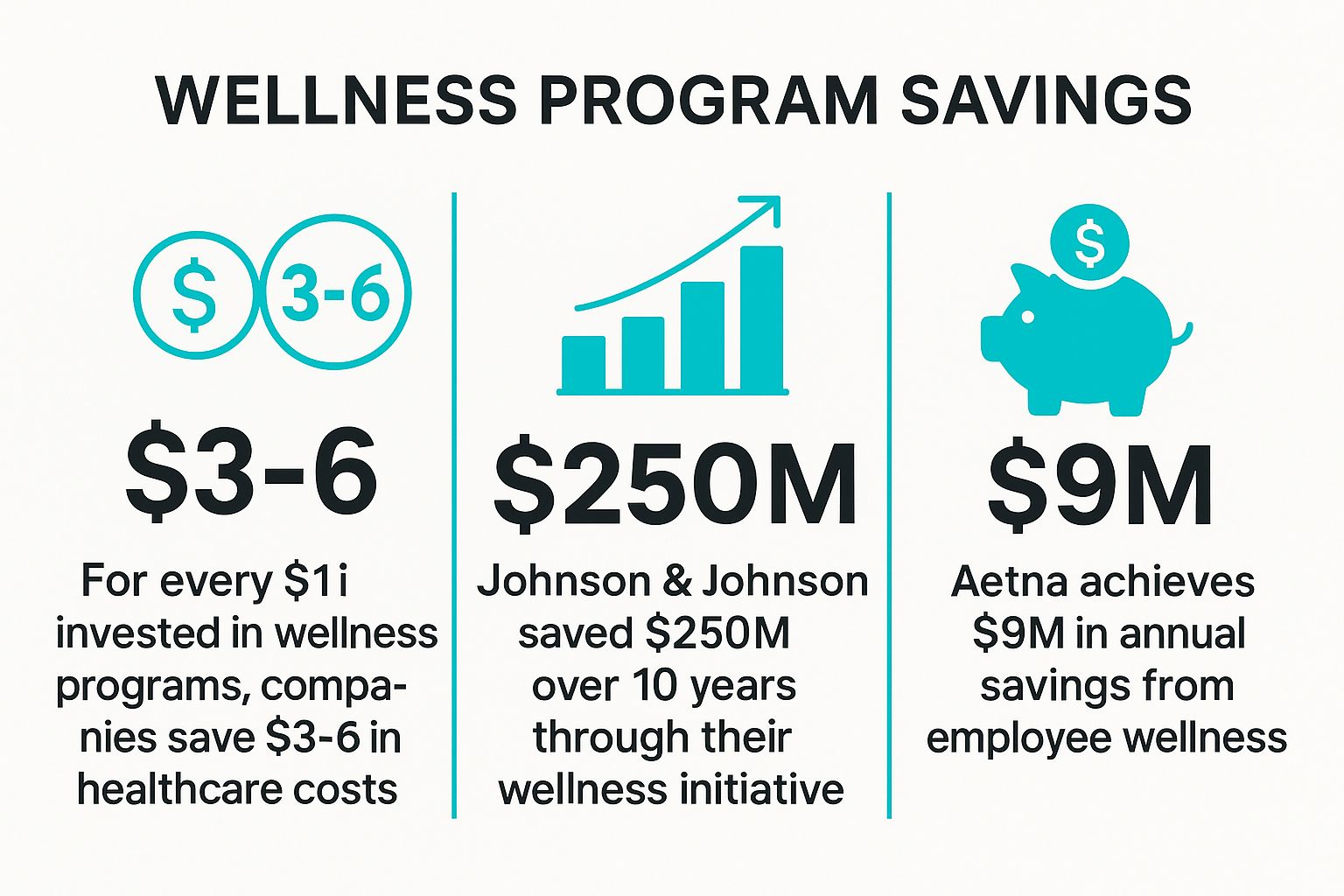

· By Annemarie
7 Employee Wellness Program Benefits for 2025 Success
In today's competitive landscape, attracting and retaining top talent requires more than just a competitive salary. A forward-thinking approach to employee well-being is no longer a perk but a strategic necessity. A well-designed corporate wellness program can transform your organization from the inside out, creating a healthier, happier, and more productive workforce. But what are the real, measurable outcomes?
This article dives deep into the most significant employee wellness program benefits that deliver a powerful return on investment. We'll move beyond generic advice to provide you with actionable strategies, statistical proof, and real-world examples. You will discover how investing in your team's health can directly fuel your company's growth and build a resilient, engaged culture.
We will explore seven key advantages, including reduced healthcare costs, increased productivity, and lower absenteeism. Each section breaks down the specific impact on your bottom line and offers practical steps for implementation. By understanding these tangible returns, you can make a compelling business case for launching or expanding a wellness initiative that truly supports your people and your strategic goals. Let's explore the data-backed reasons why these programs are a critical investment.
1. Reduced Healthcare Costs
One of the most significant and quantifiable employee wellness program benefits is a direct reduction in organizational healthcare costs. Proactive wellness initiatives shift the focus from reactive treatment to preventive care, addressing health risks before they escalate into costly chronic conditions. By encouraging healthier lifestyles, these programs lead to fewer insurance claims, reduced hospital visits, and lower pharmaceutical expenses for both the employee and the employer.
This cost-saving potential is not theoretical; it's a proven financial strategy. Companies that invest in employee well-being see a tangible return on investment (ROI). Pioneers in corporate wellness like Johnson & Johnson have demonstrated this effect over the long term, saving an estimated $250 million on healthcare costs over a decade. Similarly, Aetna's comprehensive wellness initiatives result in approximately $9 million in annual savings, proving the model's scalability and effectiveness.
How It Works: A Proactive Approach
The core principle is simple: a healthier workforce is less expensive to insure. Wellness programs achieve this by:
- Preventing Chronic Diseases: Programs focusing on nutrition, fitness, and stress management help mitigate risks for conditions like diabetes, heart disease, and hypertension.
- Encouraging Early Intervention: Offering on-site health screenings and regular check-ups helps catch potential health issues early, when treatment is simpler and less expensive.
- Promoting Healthy Habits: Education and incentives for physical activity and healthy eating lead to sustained lifestyle changes, reducing the overall health risk profile of the workforce.
The following infographic highlights the compelling financial returns that organizations can achieve by investing in employee wellness.

These figures clearly illustrate that the financial benefits of a well-structured wellness program are substantial and well-documented.
Actionable Tips for Implementation
- Partner with Healthcare Providers: Negotiate with insurance carriers or local clinics to offer employees discounted health screenings, gym memberships, and preventive care services.
- Implement Tiered Premiums: Consider an insurance model where employees who actively participate in wellness programs or meet certain health benchmarks (e.g., non-smoker status) pay lower premiums.
- Offer On-Site Convenience: If feasible, provide an on-site clinic for basic preventive care, flu shots, and health consultations. This convenience dramatically increases employee participation.
- Track Key Metrics: Monitor aggregate, anonymized data on metrics like blood pressure, cholesterol levels, and BMI to measure the program's impact on employee health and adjust strategies accordingly.
2. Increased Employee Productivity
Another primary benefit of a robust employee wellness program is a significant boost in overall productivity. When employees feel their best physically and mentally, their professional performance naturally improves. Wellness initiatives focused on nutrition, exercise, and mental health directly contribute to higher energy levels, improved focus, and enhanced cognitive function, translating into a workforce that is more engaged, efficient, and innovative.
This increase in output is a direct result of employees having the resources to manage stress, improve sleep quality, and maintain consistent energy throughout the day. Companies with well-established wellness programs report that their teams make fewer errors, demonstrate stronger problem-solving skills, and maintain higher performance standards. For example, tech giants like Google and Microsoft have reported measurable productivity gains, with Microsoft noting a 15% increase after implementing its comprehensive wellness initiatives. Similarly, Salesforce saw improved performance metrics following the rollout of its renowned mindfulness and wellness programs.

How It Works: Fostering a High-Performance Culture
The connection between well-being and performance is clear: healthy employees are better equipped to handle the demands of their roles. Wellness programs create a high-performance environment by:
- Enhancing Mental Clarity: Mindfulness, meditation, and stress-reduction resources help employees clear their minds, leading to better decision-making and creativity.
- Boosting Physical Energy: Encouraging regular physical activity and providing healthy nutrition options combats workplace fatigue and afternoon slumps.
- Improving Sleep Quality: Education on sleep hygiene is a critical component, as well-rested employees are more alert and focused. You can find valuable insights on how to function on little sleep on enjoyupside.com when necessary.
These elements combine to create a positive feedback loop where employees feel supported, valued, and empowered to perform at their peak.
Actionable Tips for Implementation
- Offer Flexible Wellness Time: Allow employees to block out time during the workday for activities like a gym session, a walk, or a meditation break without stigma.
- Promote an Active Environment: Introduce standing desks, encourage "walking meetings," and create designated stretching areas to combat a sedentary work culture.
- Provide Healthy Fuel: Stock breakrooms with nutritious snacks, fresh fruit, and hydration stations to provide a healthy alternative to sugary or processed foods.
- Implement Micro-Break Reminders: Use digital tools or team-wide reminders to encourage short, frequent breaks for stretching and screen-free time to prevent burnout and maintain focus.
3. Enhanced Employee Engagement and Morale
A key benefit of employee wellness programs is their profound impact on engagement and morale. When a company invests in the holistic well-being of its team, it sends a powerful message: we care about you as a person, not just an employee. This demonstration of genuine support fosters a deeper emotional connection to the organization, boosting job satisfaction and creating a more positive, energetic workplace culture.

Employees who feel valued and supported are more likely to be invested in their work, leading to increased discretionary effort and stronger loyalty. This is not just about feeling happy; it's about building a reciprocal relationship where support for personal health translates into professional commitment. Companies like Zappos, known for its focus on employee happiness, achieved 90% engagement rates by deeply integrating wellness into its culture. Similarly, Patagonia's comprehensive approach contributes to an exceptionally low annual turnover rate of just 4%.
How It Works: Fostering a Supportive Culture
The principle behind this benefit is that psychological well-being is directly linked to professional motivation. A supportive environment reduces stress and burnout, freeing up mental and emotional energy for employees to focus on their roles. Wellness initiatives achieve this by:
- Demonstrating Organizational Care: Actions speak louder than words. Offering resources for physical and mental health proves the company’s commitment to its people.
- Building Community: Group wellness challenges, fitness classes, and workshops create opportunities for colleagues to connect on a personal level, strengthening team bonds.
- Boosting Energy and Focus: Healthy employees have more vitality. For tips on maintaining high energy levels, learn how to boost energy naturally.
This positive cycle, where supported employees become engaged employees, is a cornerstone of a thriving and resilient organizational culture.
Actionable Tips for Implementation
- Survey Employees: Regularly ask your team what wellness initiatives they would find most valuable. A program tailored to their actual needs and preferences will see much higher engagement.
- Celebrate Milestones: Publicly and meaningfully recognize wellness achievements, whether it's completing a fitness challenge, a team step goal, or a mindfulness milestone.
- Ensure Leadership Participation: Encourage leaders to actively participate and share their own wellness journeys. Visible buy-in from the top legitimizes the program and inspires others to join.
- Create Social Opportunities: Design wellness activities that have a social component, such as team-based challenges, group yoga sessions, or healthy cooking classes to build camaraderie.
4. Reduced Absenteeism
A key operational advantage stemming from employee wellness program benefits is a marked reduction in absenteeism. When employees are healthier, they are less susceptible to common illnesses, suffer from fewer chronic conditions, and manage stress more effectively. This translates directly into fewer sick days, less time off for medical appointments, and more consistent attendance, which bolsters team productivity and reduces the strain on coworkers who have to cover for absent colleagues.
This connection is well-documented and delivers a powerful boost to operational efficiency. Studies consistently show that robust wellness programs can decrease absenteeism by 25-30% by improving overall health and providing early intervention. Corporate pioneers like the 3M Company saw absenteeism fall by an incredible 50% after launching their comprehensive wellness program. Similarly, Motorola achieved a 30% reduction in sick days, proving that investing in employee health keeps people present and engaged.
How It Works: A Healthier Workforce is a More Present Workforce
The underlying mechanism is straightforward: a focus on proactive health directly minimizes the primary causes of employee absence. Wellness programs accomplish this by:
- Preventing Illness: Initiatives that promote good nutrition, regular exercise, and immunizations (like flu shots) strengthen employees' immune systems, reducing instances of short-term sickness.
- Managing Chronic Conditions: Support for managing conditions like diabetes or hypertension helps employees control their health, preventing complications that require time off.
- Improving Mental Health: By providing resources for stress management and mental well-being, programs reduce burnout and mental health days, which are a leading cause of absenteeism.
Actionable Tips for Implementation
- Track Attendance Patterns: Use attendance data to identify trends and measure the direct impact of your wellness initiatives over time. This helps demonstrate ROI and refine program focus.
- Offer On-Site Convenience: Providing on-site flu shots, biometric screenings, or health consultations removes barriers to access and encourages preventive care, reducing the need for off-site appointments.
- Provide Flexible Arrangements: For minor health issues that don't require a full day off, offer flexible work-from-home options. This can prevent a full day of absence while still allowing the employee to recover.
- Implement Return-to-Work Support: For employees returning after a longer illness, offer support programs to ease their transition back, ensuring they feel supported and can maintain their health.
5. Improved Employee Retention
Beyond immediate health improvements, one of the most valuable long-term employee wellness program benefits is a significant boost in employee retention. Wellness programs act as a powerful retention tool by showing a company’s genuine investment in its people's long-term health and success. This commitment creates a strong emotional bond, making employees feel valued and supported far beyond their direct compensation.
This enhanced loyalty translates into lower turnover rates, which saves the organization immense costs associated with recruitment, hiring, and training. Companies known for their robust wellness offerings often become employers of choice. For instance, the SAS Institute maintains a remarkable 95% employee retention rate, partly attributed to its comprehensive wellness offerings. Similarly, Salesforce reduced turnover by 40% after expanding its mental health and wellness programs, demonstrating that investing in well-being is a direct investment in retaining top talent.
How It Works: Fostering Loyalty and Value
The core idea is that employees who feel cared for are less likely to leave. Wellness programs build this sense of loyalty by:
- Demonstrating Long-Term Investment: Programs that support employees through various life stages show the company is committed to their entire career journey.
- Providing Tangible Value: Benefits like gym memberships, mental health support, and financial counseling offer real, practical value that employees would otherwise have to pay for themselves.
- Creating a Positive Culture: A culture that prioritizes health and work-life balance becomes a key reason for employees to stay, even when offered higher salaries elsewhere.
These initiatives signal that an employer views its workforce as its most valuable asset, fostering a culture of mutual respect and commitment that is difficult for competitors to replicate.
Actionable Tips for Implementation
- Communicate Total Value: During onboarding and performance reviews, clearly articulate the monetary and non-monetary value of the wellness benefits package to reinforce its importance.
- Create Multi-Year Wellness Journeys: Design programs that evolve with employees, offering different types of support as they progress in their careers and personal lives, encouraging long-term engagement.
- Survey Departing Employees: Use exit interviews to specifically ask about the perceived value and shortcomings of the wellness program. This feedback is invaluable for refinement.
- Continuously Evolve Programs: Regularly survey current employees to ensure the wellness offerings are relevant to their changing needs, life stages, and priorities.
6. Enhanced Company Culture and Team Building
A significant benefit of employee wellness programs is their power to enhance company culture and foster genuine team building. These initiatives create shared experiences and common goals that transcend job titles and departmental divides. When employees participate in group fitness challenges, wellness workshops, or team-based health activities, they build relationships, strengthen communication, and develop a sense of camaraderie that translates directly back into the workplace.
This cultural transformation is a core strategic advantage. A positive, supportive culture built on mutual well-being attracts and retains top talent. Companies known for their integrated wellness cultures, such as Nike and Lululemon, demonstrate how this focus becomes a core part of their brand identity and operational success. This approach turns a workplace into a community, improving collaboration, innovation, and overall organizational cohesion. Learn more about how modern corporate wellness solutions can be a catalyst for cultural change.
How It Works: A Collaborative Approach
The principle is that shared, positive experiences build stronger teams. Wellness programs facilitate this by:
- Breaking Down Silos: A company-wide step challenge or a group yoga class brings together employees from finance, marketing, and engineering, fostering informal networks and cross-departmental understanding.
- Fostering Mutual Support: When colleagues encourage each other to meet a fitness goal or share healthy recipes, they build a foundation of support and trust that extends to professional projects.
- Aligning Values: A corporate commitment to wellness sends a powerful message that the company cares about its people as individuals, not just as workers, which strengthens employee loyalty and engagement.
Actionable Tips for Implementation
- Offer Diverse Activities: Ensure your wellness offerings cater to a wide range of interests and fitness levels, from high-intensity interval training to gentle stretching, meditation, and healthy cooking classes.
- Create Inclusive Challenges: Design team-based challenges that celebrate collective achievements rather than focusing solely on individual competition. This encourages collaboration and prevents less-active employees from feeling excluded.
- Rotate Program Leadership: Establish a wellness committee with rotating members from different departments. This ensures a variety of perspectives are included and increases buy-in across the organization.
- Integrate Wellness into Onboarding: Introduce new hires to the company’s wellness culture from day one. This sets the tone and shows that well-being is a fundamental part of the employee experience.
7. Reduced Workers' Compensation Claims
Another powerful employee wellness program benefit is the significant reduction in workplace injuries and subsequent workers' compensation claims. By fostering a culture of health and safety, organizations can directly mitigate the risks associated with on-the-job accidents. Wellness programs improve employee physical fitness, increase ergonomic awareness, and embed injury prevention knowledge into the company's DNA, creating a safer, more resilient workforce.
This proactive safety approach delivers substantial financial returns. When employees are stronger, more flexible, and more mindful of their physical environment, they are less prone to strains, sprains, and other common workplace injuries. Companies like Caterpillar have seen dramatic results, reducing workers' compensation claims by 45% through integrated wellness and safety programs. Similarly, UPS decreased workplace injuries by 35% using fitness-based injury prevention, proving that investing in employee physical health is a direct investment in workplace safety.
How It Works: Building a Culture of Safety
The connection is straightforward: a healthier employee is a safer employee. Wellness initiatives contribute to fewer claims by:
- Improving Physical Conditioning: Programs that encourage strength, flexibility, and cardiovascular health reduce the likelihood of physical injuries, especially in physically demanding roles.
- Enhancing Ergonomic Awareness: Educating employees on proper posture, lifting techniques, and workstation setup helps prevent repetitive strain injuries and musculoskeletal disorders.
- Promoting Mental Alertness: Stress management and mental health support contribute to improved focus and alertness, reducing the risk of accidents caused by fatigue or distraction.
The following infographic highlights how targeted wellness initiatives can dramatically lower injury rates and associated costs.
These statistics underscore the direct link between a comprehensive wellness strategy and a safer, less costly work environment.
Actionable Tips for Implementation
- Integrate Safety and Wellness: Combine safety training modules with fitness education. For example, host a workshop on proper lifting techniques followed by a core strengthening class.
- Conduct Ergonomic Assessments: Regularly evaluate workstations and work processes. Provide ergonomic equipment and training to minimize physical strain on employees.
- Implement Pre-Shift Conditioning: For physically demanding jobs, start shifts with a brief routine of stretching and light exercises to warm up muscles and prevent injuries.
- Track Injury Data: Analyze injury patterns to identify high-risk areas or roles. Use this data to tailor specific wellness interventions, such as offering targeted flexibility programs for a department with high rates of back strain.
Employee Wellness Benefits Comparison Table
| Wellness Outcome | Implementation Complexity 🔄 | Resource Requirements ⚡ | Expected Outcomes 📊 | Ideal Use Cases 💡 | Key Advantages ⭐ |
|---|---|---|---|---|---|
| Reduced Healthcare Costs | Medium: Requires setup and ongoing tracking | Moderate to High: Health screenings, monitoring, insurance integration | Significant cost savings ($3-6 for every $1 invested), long-term ROI (2-3 years) | Organizations aiming to reduce medical expenses | Measurable ROI, reduced insurance claims, chronic disease prevention |
| Increased Employee Productivity | Medium: Needs cultural adaptation and participation | Moderate: Fitness, mental health programs, ergonomic assessments | 10-15% productivity increase, better focus, fewer errors | Companies seeking performance and efficiency gains | Improved work quality, decision-making, creativity |
| Enhanced Employee Engagement and Morale | Medium to High: Ongoing communication, leadership involvement | Moderate: Team challenges, rewards, peer networks | Higher job satisfaction, stronger emotional connection | Firms focusing on culture and retention | Stronger loyalty, increased participation, better teamwork |
| Reduced Absenteeism | Medium: Comprehensive implementation required | Moderate: Vaccination, health coaching, on-site services | 25-30% reduction in absenteeism, improved attendance consistency | Companies with high sick leave rates | Lower staffing costs, better project continuity |
| Improved Employee Retention | High: Long-term program and benefit integration | High: Extensive wellness and development resources | Up to 50% lower turnover, reduced recruitment and training costs | Organizations prioritizing talent retention | Preserves knowledge, stronger employer brand |
| Enhanced Company Culture and Team Building | Medium: Coordination across departments | Moderate: Team events, committees, mentorships | Improved collaboration, stronger community and innovation | Companies wanting to enhance teamwork and culture | Better communication, leadership development, cohesion |
| Reduced Workers' Compensation Claims | Medium to High: Safety and ergonomic training | Moderate to High: Ergonomics, conditioning, safety education | 20-40% reduction in claims, fewer lost-time injuries | Workplaces with high injury risks | Lower premiums, safer work environment, reduced costs |
From Benefits to Blueprint: Building Your DWellness Strategy
The evidence presented throughout this article is compelling and clear: the advantages of implementing a comprehensive employee wellness program are not just a "nice-to-have" perk but a strategic business imperative. We've moved beyond the abstract, exploring tangible outcomes that directly impact your bottom line and organizational health. From the significant reduction in healthcare costs and workers' compensation claims to the powerful surge in employee productivity and engagement, the ROI of investing in your team's well-being is undeniable.
These programs are the bedrock of a thriving workplace. They send a clear message that you value your employees as whole individuals, not just as contributors to a task list. This fosters a culture of mutual respect and support, which is the secret ingredient to reducing absenteeism and, more importantly, improving long-term employee retention. When people feel cared for, they are more motivated, loyal, and connected to the company's mission. The employee wellness program benefits we've detailed are not isolated gains; they are interconnected components of a high-performing, resilient organization.
Turning Insight into Action
Understanding the benefits is the first step, but building a successful program requires a deliberate, strategic approach. The most effective wellness initiatives are not one-size-fits-all; they are tailored to the unique needs and demographics of your workforce. The journey from concept to reality involves several key actions:
- Listen First: Before launching any initiative, survey your employees. Use anonymous questionnaires or focus groups to understand their specific health concerns, interests, and what they would value most in a wellness program.
- Secure Leadership Buy-In: A wellness program thrives when it is championed from the top down. Present a clear business case to leadership, highlighting the financial and cultural benefits to ensure you have the necessary budget and vocal support.
- Start Small and Scale: You don’t need to launch a massive, multi-faceted program overnight. Begin with one or two high-impact initiatives, like a mental health resource subscription or a steps challenge. Measure the results, gather feedback, and build momentum from there.
Ultimately, mastering these concepts means shifting your perspective from viewing wellness as an expense to recognizing it as a crucial investment in your company's most valuable asset: its people. A well-executed strategy creates a positive feedback loop where healthier, happier employees drive better business results, which in turn allows for further investment in their well-being. This is how you build not just a good company, but a great place to work.
Ready to add a modern, practical solution to your wellness toolkit that supports a "work hard, play hard" culture? Upside Hangover Sticks offer a unique way to help your team stay sharp and productive, even after networking events or team celebrations. Learn more about how you can support your employees' well-being and keep them at their best by visiting Upside Hangover Sticks today.
